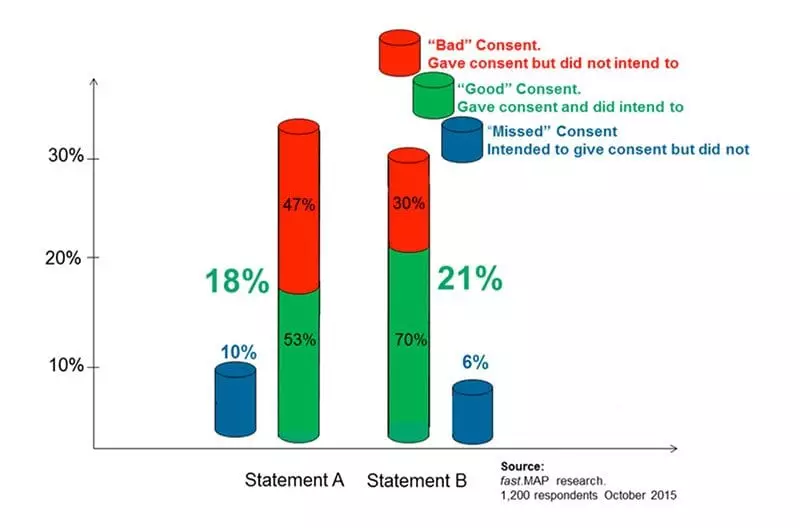The three strong fundraising contact motivators
New research has identified – the three pillars of charity consent-to-contact. Get them right and permission levels will improve.
Pillar 1: Opt in versus Opt out
When respondents need to tick a box to stop consent this is called “opt-out”. When respondents tick a box to give consent, this is called “opt-in”.
While opt-out results in more consent than opt-in, the quality of the consent generated with this method is also more questionable. Opt-out attracts far more consents than opt-in because of people’s impatience or confusion.
fast.MAP’s Consent Optimising Benchmarks have revealed the uncomfortable truth that confusing permission statements often generate more consents. People often skim-read statements to pick out key facts. Some will misunderstand. Many will consent by default by assuming the act of ticking is a commitment and so avoid doing it.
How the quality of consent may vary as a result is shown below.
Regulation and codes of practice are increasingly moving towards opt-in. Wise charities are making contingency plans for a future when “Clear and affirmative consent” will be mandatory.
Pillar 2: Channel choice
It is particularly difficult to gain consent to communicate via some media while others are far more popular. The order, combination and prioritisation of channels all influence consent rates. For example, bundling an unpopular channel with a popular channel will lift consent to the unpopular channel and lower it for the popular one. The process of channel choice often erupts into intense internal wrangling as managers negotiate the relative importance of the fundraising channels they control.
Media channel selection often needs to be adapted to maximise collection of higher quality consenters – which may make some of the more expensive media more cost-effective.
Advertisement
Pillar 3: Language
fast.MAP’s Consent Optimising Benchmarks research on hundreds of permission statements, involving interviews with more than 50,000 respondents has proved that words matter – massively. A change of language can dramatically increase the level of consent.
Use every ounce of copywriting creativity and marketing know-how to persuade prospects they’d benefit from staying in touch with you. Charities utilise persuasion in every other area of marketing, so why not when creating permission statements.
There are 14 attributes (for example, trust, clarity and control) which have an influence on people’s decision to give consent. The linguistic presentation and prioritisation of these competing qualities significantly affects consent levels. Impatient consumers have a consent attention-span of a few seconds, so the selection, order and placement of every word and comma really matters.
You can find out more about enhancing your permission statement in fast.MAP’s ‘Guide to Creating Charity Permission Statements’ – normally £50 but free for UK Fundraising readers who use the following download code: COGCH0316.




